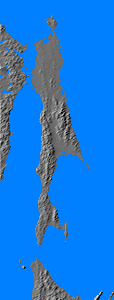![]() The Pacific War Online Encyclopedia
The Pacific War Online Encyclopedia
|
| Previous: Karachi | Table of Contents | Next: Karaganda |

Karafuto was the Japanese-controlled
southern half of Sakhalin Island, just north of Hokkaido.
The major port was Otomari.
The territory was awarded to Japan by the Treaty of Portsmouth in 1905,
and a flood of Japanese immigrants soon overwhelmed the 1300 indigenous Ainu. The territory was supervised by
the Ministry of Colonial Affairs until late 1942, when the latter was
absorbed into the new created Greater
East Asia Ministry and Karafuto became an integral part of the
Japanese home islands. The governor-general held high bureaucratic rank (chokunin) but was not usually a military officer.
The valley of the Tym' and Poronai Rivers forms the chief communication
corridor between north and south, and the Japanese placed most of their defenses here, around the town of Koton (Pobedino; 142.828E 49.843N). By August 1945, the defense consisted of 88 Division, with 125 Regiment manning the fortified zone around Koton and the remainder of the division dispersed through Karafuto.
The Koton Fortified Region was 7.5 miles (12 km) wide and up to 10
miles (16 km) deep. The defenses were organized into a security zone
1.5-2 miles (2-3 km) deep backed by a security belt 5 miles (8 km)
further back. Fortifications in the security belt included two
reinforced concrete pillboxes, four earth and timber
pillboxes, and 22 concrete embrasures and extensive barbed wire and
antitank obstacles. Behind the security belt was the main line of
resistance, with over one hundred pillboxes and bunkers. A final
defensive belt, though with few fortifications, lay to the rear of the
main line of resistance. The total defending force was 5400 men with 42
heavy machine guns, 94 light machine guns, 28 guns and mortars, and 27 grenade launchers.
On 11 August 1945, the Russians
launched a major attack on
Karafuto from northern Sakhalin. 1 Far East Front intended to use
Karafuto as a springboard for an invasion
of Hokkaido, but
the attacking 56 Rifle Corps met furious resistance at the Honda strong
point and was unable to break the main Japanese defensive belt until 18
August. The Japanese conducted a fighting withdrawal and could not be overcome before 3 September
1945, even after 113 Rifle Regiment was landed at Maoka (Kholmsk; 142.058E 47.045N) on 16 August to flank the Japanese. The combination of fanatical resistance from the Japanese and diplomatic pressure from Truman, based on provisions of
the Potsdam agreement placing Hokkaido within the American occupation zone,
prevented Russian occupation of Hokkaido.
References
Frank (1999)
The Pacific War Online Encyclopedia © 2007-2009, 2012, 2014 by Kent G. Budge. Index